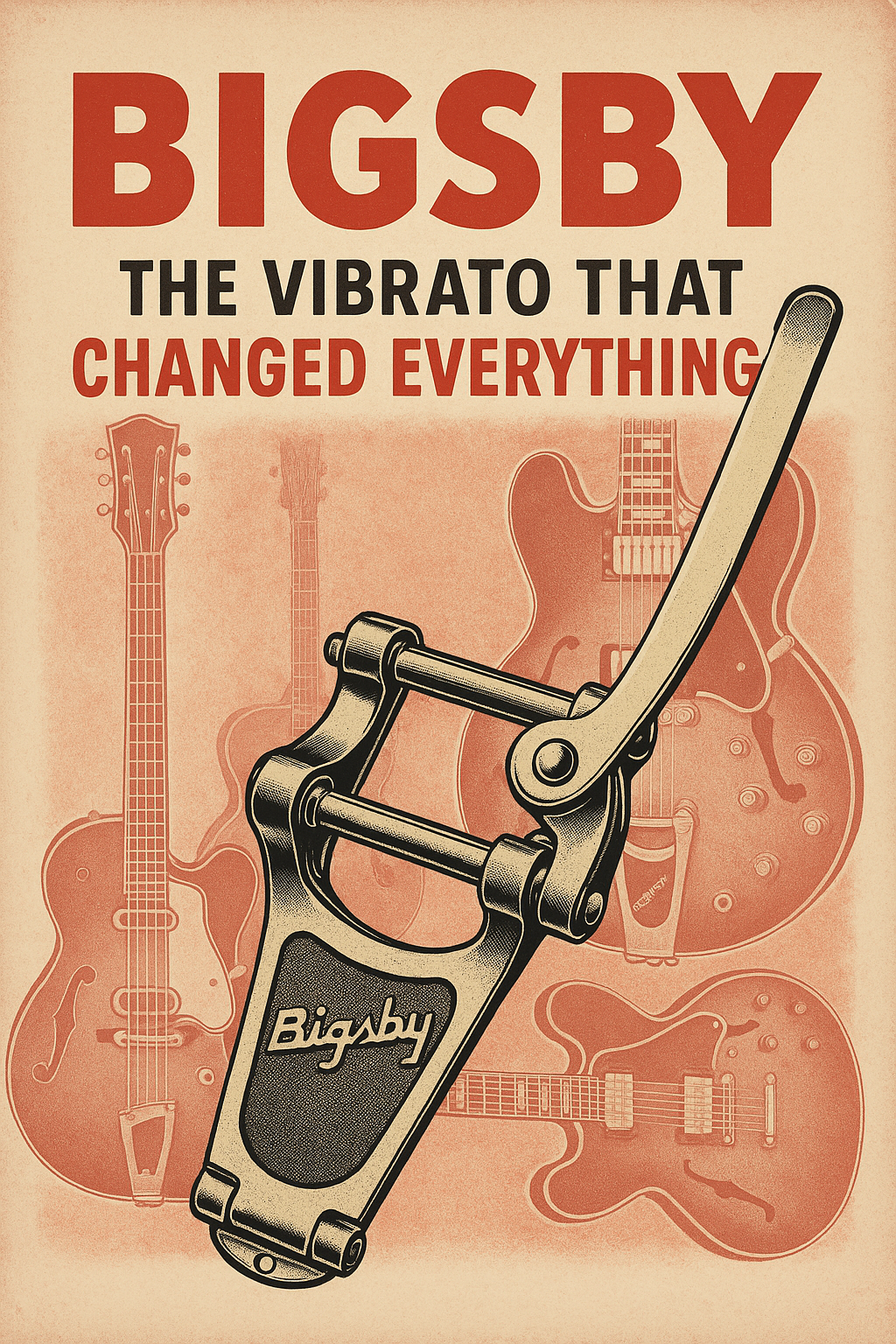When you hear the name Bigsby, you probably picture a shimmering vibrato arm gliding under a guitarist’s hand, or maybe a sleek archtop with a distinctive curving headstock. But the Bigsby name runs deeper than a single piece of hardware — it’s a story of innovation, craftsmanship, and a lasting influence on guitar design.
Origins: Paul Bigsby and the Birth of an Icon
Paul Adelburt Bigsby was a skilled motorcycle racer and engineer who, in the 1940s, turned his mechanical talents toward the emerging electric guitar world. Initially repairing instruments for friends like country legend Merle Travis, Bigsby soon began making his own custom guitars.
His early designs were groundbreaking:
-
Solid Body Electric Guitars (1948) — Before Fender’s Broadcaster (later Telecaster) hit the market, Bigsby was building sleek, solid-body electrics with a single cutaway and a distinctive headstock design — one that many say inspired Fender’s six-in-line tuner arrangement.
-
Unique Headstock & Hardware — His headstocks, tailpieces, and bridges all featured a level of engineering precision uncommon at the time, blending motorcycle-style machining with luthier artistry.
Bigsby Guitars: Precision in Limited Numbers
While Bigsby guitars are rare (fewer than 100 are believed to have been made by Paul himself), they were beloved by early adopters in country, western swing, and rockabilly. These instruments stood out for their smooth playability, flawless fretwork, and unique aesthetic — all hand-built with meticulous attention to detail.
Notable players included:
-
Merle Travis – whose custom Bigsby inspired countless copycats.
-
Speedy West – a steel guitar virtuoso who also used Bigsby’s pedal steel innovations.
The Bigsby Vibrato: A Revolution in Guitar Expression
The most enduring Bigsby invention is without doubt the Bigsby True Vibrato Tailpiece, introduced in the early 1950s. Unlike fixed bridges, the Bigsby allowed guitarists to bend notes and chords smoothly, creating a gentle, warbling vibrato.
What made it different?
-
Spring-Loaded Arm – Provided a smooth, subtle pitch change rather than the dive-bombing effect of later systems like the Floyd Rose.
-
Roller Bar Design – Reduced friction at the bridge, allowing for better tuning stability (by the standards of the time).
-
Versatility – Could be fitted to hollowbodies, semi-hollows, and even solid-bodies without major structural changes.
The Bigsby quickly found its way onto Gretsch, Gibson, Guild, and Epiphone models, becoming a visual and sonic trademark of rockabilly, surf rock, and early rock ’n’ roll.
Bigsby Pickups: Clear, Articulate, and Ahead of Their Time
Before focusing solely on hardware, Paul Bigsby also designed his own single-coil pickups. Unlike Fender’s narrow, bright-sounding coils or Gibson’s warmer P-90s, Bigsby pickups were:
-
Wide and Flat – Producing a clear, hi-fi tone with strong bass and crisp treble.
-
Hand-Wound – Each was wound by Bigsby himself, giving them a unique sonic signature.
-
Popular with Steel Guitars – Their clarity made them especially suited to pedal and lap steel applications.
Some modern boutique winders still chase the “Bigsby pickup tone,” but originals remain rare and highly sought after by collectors.
Influence and Legacy
By the 1960s, Bigsby Manufacturing was producing vibratos almost exclusively, with guitar building taking a back seat. Paul Bigsby sold the company to Ted McCarty (former Gibson president) in 1966, ensuring the brand’s continuity.
Today, Bigsby is part of the Gretsch family under Fender’s stewardship, but the classic B3, B5, B6, and B7 vibratos are still made much like they were in the ’50s. Players from Chet Atkins to Neil Young, Brian Setzer, and Noel Gallagher have relied on Bigsby units for their expressive, shimmering character.
What Makes Bigsby Different?
-
Smooth, Subtle Vibrato – Not for metal dive-bombs, but perfect for chord shimmers, slow bends, and a “breathing” guitar tone.
-
Timeless Design – The same curves and chrome that graced 1950s Gretsches are still in production today.
-
Historic Significance – Predating many modern vibrato systems and influencing headstock, pickup, and body design in the formative years of the electric guitar.
In the world of guitar gear, some names fade while others become immortal. Bigsby belongs firmly in the latter category — a testament to the vision of a motorcycle mechanic who forever changed the sound of the electric guitar.









